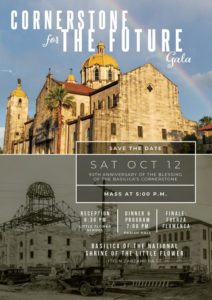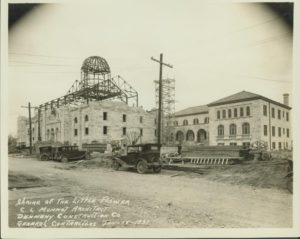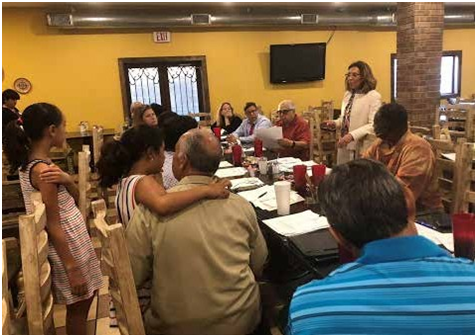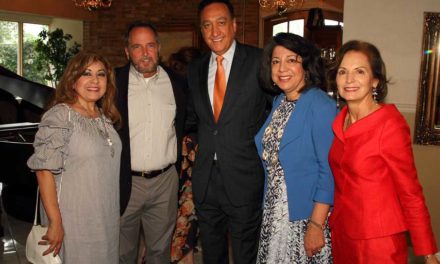Approximately twenty (20) stakeholders met Thursday, September 19th at the Los Angeles Tortilleria, Bakery and Restaurant on 300 N. Zarzamora Street for the first Zarzamora Merchant’s Association Meeting. Business owners, community members, City of San Antonio departmental staff and heads of the UTSA College of Architecture, Construction and Planning department gathered to encourage stakeholders from the corridor to get connected and be a part of the new growth and development on the West Side.
 The idea for the Zarzamora Merchant’s Association was first born through the conversations of Carlos Gonzalez (Co-Chair for the West End Hope and Action, a coalition of community organizations that meet bi-weekly to organize actionable community initiatives) and Martin Vasquez, the late owner of Los Angeles Tortilleria, Bakery and Restaurant. The two met in 2011 when Carlos was teaching citizenship classes at Academia América, the 501 (c) (3) nonprofit organization where Martin, originally from Zacatecas, Mexico, was a student at the time. The two saw an overlap of community and economic development specific to corridors with Martin opening the first Los Angeles Tortilleria, Bakery and Restaurant on Zarzamora in January of 2007 and Carlos working with the community. The idea was to “take investment and resources to improve the business climate for businesses on Zarzamora street,” said Gonzalez.
The idea for the Zarzamora Merchant’s Association was first born through the conversations of Carlos Gonzalez (Co-Chair for the West End Hope and Action, a coalition of community organizations that meet bi-weekly to organize actionable community initiatives) and Martin Vasquez, the late owner of Los Angeles Tortilleria, Bakery and Restaurant. The two met in 2011 when Carlos was teaching citizenship classes at Academia América, the 501 (c) (3) nonprofit organization where Martin, originally from Zacatecas, Mexico, was a student at the time. The two saw an overlap of community and economic development specific to corridors with Martin opening the first Los Angeles Tortilleria, Bakery and Restaurant on Zarzamora in January of 2007 and Carlos working with the community. The idea was to “take investment and resources to improve the business climate for businesses on Zarzamora street,” said Gonzalez.
However, after Martin unexpectedly passed away in 2013, the Zarzamora Merchant’s Association project paused. It wasn’t until City of San Antonio District Five Councilwoman Shirley Gonzales created the Legacy Corridor Business Alliance program which aims to help small businesses thrive on the Westside (specifically ten corridors which were strategically selected – Buena Vista, Castroville Rd., Colorado, Culebra, Guadalupe, General McMullen, Laredo, Nogalitos, West Commerce and Zarzamora), that the idea for the Association was reborn.
The Legacy Corridor Westside Business Alliance (WBA) program is administered by Westside Development Corporation (WDC), a 501 (c) (3) created in 2006. The mission of WDC is to “foster economic development, promote the development and redevelopment of real estate within Westside San Antonio, create viable urban communities, and preserve the character, culture and history of the Westside.”
WDC President and CEO Leonard Rodriguez says that he is “especially encouraged to see that businesses are excited about working collectively as a team to seek tangible improvements.” The impact of the support for the Zarzamora Merchant’s Association and its parallel corridor coalitions, cannot be overstated, Carlos and the group he works with, “appreciates the leadership of WDC in the larger picture of San Antonio’s growth and development.”
The Los Angeles Tortilleria, Bakery and Restaurant has grown into two (soon to be three) restaurant locations – Zarzamora/Travis, Commercial Avenue/Hutchins and new location Jackson Keller/Blanco which is opening soon, and is run by Martin’s wife Alejandra and their children, including son Miguel who attended the first Zarzamora Merchant’s Association meeting.
For more information on the Legacy Corridor Westside Business Alliance (WBA) program, please call (210) 501-0192.
Celebrating the 90th Anniversary of the Basilica Cornerstone
 The Discalced Carmelite Friars of San Antonio will host the celebration of the Basilica’s past, and preview of its future on Saturday October 12.
The Discalced Carmelite Friars of San Antonio will host the celebration of the Basilica’s past, and preview of its future on Saturday October 12.
A reception at Little Flower School will begin at 5 p.m followed by the program and dinner at 7 p.m.
Cecilia Abbott, First Lady of Texas, will be the keynote speaker. Randy Beamer of News 4 will serve as our emcee. Fuerza Flamenca dancers will perform the finale of the evening.
The ceremonial blessing of the foundation stone, a symbol of Christ, was held on Oct. 15, 1929, with Archbishop of San Antonio, Arthur Drossaerts and the Discalced Carmelite friars of the Province of St. Therese, which today still administers the Basilica.
 Basilica of the National Shrine of the Little Flower is dedicated to serving the community as a sacred space and place of spiritual pilgrimage and apostolic activity, where persons of all faiths can renew their commitment to God and grow in their journey of faith. The church provides a variety of religious services for the entire Archdiocese of San Antonio, with countless visitors from around the city and tourists to the city as well as 950 registered parishioner families. Dedicated in 1931, the Shrine is on the National Register of Historic Places and was elevated to the status of Basilica in the Catholic Church by Pope John Paul II in 1998.
Basilica of the National Shrine of the Little Flower is dedicated to serving the community as a sacred space and place of spiritual pilgrimage and apostolic activity, where persons of all faiths can renew their commitment to God and grow in their journey of faith. The church provides a variety of religious services for the entire Archdiocese of San Antonio, with countless visitors from around the city and tourists to the city as well as 950 registered parishioner families. Dedicated in 1931, the Shrine is on the National Register of Historic Places and was elevated to the status of Basilica in the Catholic Church by Pope John Paul II in 1998.
The Basilica is one of only 86 in the United States and one of only four in the state of Texas bearing the papal designation of Basilica, the highest permanent designation for a church. Known as centers of spiritual and apostolic activity for the Catholic faithful, basilicas are traditionally required to hold historical, architectural and artistic value and significance as an active center of pastoral liturgy.
 Dedicated to St. Therese of Lisieux, known as “The Little Flower,” the Basilica was built during the Great Depression (1929-31) by Spanish Discalced Carmelite friars to promote devotion to St. Therese following her 1925 canonization.
Dedicated to St. Therese of Lisieux, known as “The Little Flower,” the Basilica was built during the Great Depression (1929-31) by Spanish Discalced Carmelite friars to promote devotion to St. Therese following her 1925 canonization.
Today the Discalced Carmelite friars of San Antonio continue are a community of five friars; they are one of five communities within the San Antonio-based Province of St. Therese, a group of 15 Friars. The friars promote the spirituality of St. Therese and other Carmelite saints through their work at the Basilica. Today, the Shrine stands as a monument to the great faith of devotees of St. Therese. The Basilica is a treasury of art, master craftsmanship, and relics. The Shrine’s numerous stained glass windows, installed beginning in the 1930s, tell the stories of the lives of Carmelite saints. The Basilica is home to three first-class relics of The Little Flower and a first-class relics of the saint’s parents, St. Louis and St. Zelie Martin.
The Little Flower Parish Conference of St. Vincent de Paul Society serves an average of 70 families in the community per month by providing assistance with utilities, rental, prescription payments and food.
The Basilica is also a premium music performance venue and was an official Tricentennial venue in 2018. As such it has many opportunities to serve the community and support local arts and culture. Numerous special events are held annually at the Basilica that are presented free and open to the community, including traditional Mexican music and dance programs, children’s day and King’s Day programs. The Basilica also collaborates with local nonprofit groups for performances of classical and sacred music.
 A Westside institution for 90 years, the Basilica exemplifies the neighborhood’s unique heritage and identity as a center of Hispanic culture. The church’s iconic golden domes are a reminder of the Westside’s legacy that makes it a vital part of San Antonio’s past and present. A preserved and eventually restored Basilica will also lay the cornerstone to the cultural renewal and preservation efforts in course on behalf of the historic Westside.
A Westside institution for 90 years, the Basilica exemplifies the neighborhood’s unique heritage and identity as a center of Hispanic culture. The church’s iconic golden domes are a reminder of the Westside’s legacy that makes it a vital part of San Antonio’s past and present. A preserved and eventually restored Basilica will also lay the cornerstone to the cultural renewal and preservation efforts in course on behalf of the historic Westside.
Please RSVP to the event by Oct. 1. Individual tickets cost $100 and a full table of 8 costs $800. Tickets can be purchased online at
Basilica of the National Shrine of the Little Flower is located at
1715 North Zarzamora Street
San Antonio, TX 78201
For more information, contact the Administration Office at (210) 735-9126







